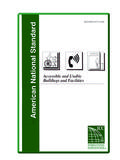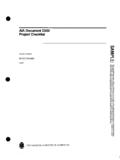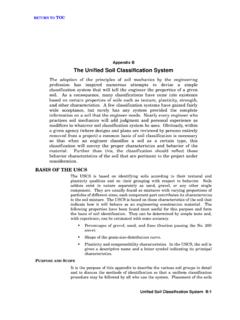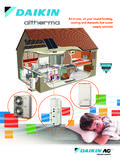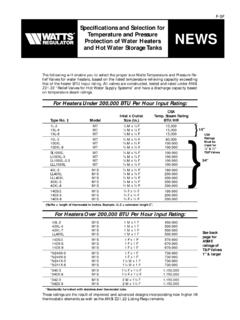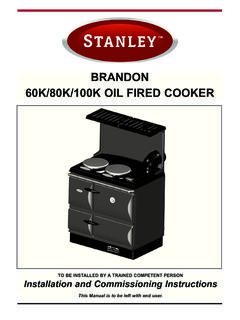Transcription of ARE-Ch9 Plumbing Systems
1 Chapter 9: Plumbing Systems WATER SUPPLY For cities: surface & ground water Aquifers: large regions of subsurface water Deep wells: best source, little or no treatment PH level: a measure of acidity or alkalinity of water- 0-14 with 7 = neutral- Below 7 = acidic- Above t = alkaline Rainwater is acidic in natural state Acid rain: sulfur & nitrogen in air. Can corrode metal pipes when system uses runoff Hardness: Ca & Mg salts in water from dissolved minerals such as limestone- Can clog or insulate pipes & corrosion of boilers- Inhibits cleaning action of detergents- Anode: rod inserted into water tank to collect hard water deposits- Softener: contains zeolite where the Ca & Mg ions exchanged for sodium ions Turbidity: suspended material such as silt clag and organic matter- Treated by filtration Color & odor caused by organic matter- Color treated with filtration or chlorination- Odor treated with filtration thru activated carbon Biological contamination.
2 Bacteria, viruses and protozoa- Coliform group found in human & animal wastePrivate Water Supply Wells, springs or collected rainwater Well considerations: depth and yield- Shallow well: less than 25 - Before drilling, ask neighbors, local well drillers and geologists for their experience Yield: gallons per minute a well provides- Min: 5 10 gpm for private residences- If yield too low, system may include storage tank- Pipe casing: 4 6 steel pipe prevents hole from caving & to prevent seepage of surfacecontamination. Lower portions are perforated to allow water to seep inPumps Suction pumps: used when water table is less than 25 Deep well jet pumps: for 25 100 deep wells Turbine pump: high capacity Systems in deep wells Submersible pump: placed below water line & pumps water into a pressure tank Jet pumps have pump and motor above ground and lift water by venturi principle.
3 Water is forcedthru pipe where a jet stream of small diameter is created Wells require storage tanks or pressure tanks - Pressure tanks maintain constant pressure to compensate for peak demands that exceedcapacity of pump- Pressure tanks also reduce amount of time pump must be running- As tank is emptied, pressure gauge senses loss and activates the pumpMunicipal Water Supply Water treatment:- Settling out heavy materials & coagulations (or flocculation) with a chemical such as particles combine w/ alum & settle- Water is then filtered and treated with chlorine to kill organics (.5ppm)- May be aerated to improve taste or fluoride added- Aeration can aid in oxidation- Piped thru mains @ 50psi (vary from 40 80psi) First task in building project: determine location of water main, its size, pressure and cost to If not adjacent to property, owner expense to extend Pressure in line is needed to determine supply systemWATER SUPPLY DESIGNS upply system Primary types: upfeed and down feed- Based on height of building & pressure required to operate fixtures Upfeed: uses pressure in water main to directly supply fixtures- Limit.
4 40 60 - Supply from city main is 50psi- Pressure must be sufficient to overcome friction in pipes, fittings, meter and static head & stillhave enough pressure to operate fixtures- Flush valve: 10 20 psi- Shower head: 12psi- Toilet: 15pas- Faucet: 7-8psi- Hose bibb: 30psi- Static head: pressure required to push water vertically or the pressure caused at the bottom ofa column of water- .433 psi to lift water 1 -0 or- 1psi will lift water - When converting from pressure (psi) to lift (ft), use ft per psi- When converting height or lift (ft) to pressure (psi) use 1/23 or .433 psi- Example I: A 10 story building has a floor to floor height of 12 , a pressure of 15psi is neededto flush toilet. What is the required water pressure at the base of the building?
5 Total lift = 10story x 12 = 120 = 120 = psiTherefore + 15psi (toilet) = Example II: If additional pressure drop of 12psi due to friction @ meter, what is requiredpressure at base?PTOTAL = + 15psi + 12psi = (min)- Example III: How much pressure is lost in static head at a fixture 40 above a water main w/pressure of 45psi (ignoring friction loss)40 (.434 lbf/in2/ft) = remaining pressure at the 40 level is:45psi = If water supply insufficient, a downfeed system or pneumatic tank must be used Downfeed system : when building is too tall for upfeed, water is pumped to storage tanks near topof building or zone served & flows by gravity to fixtures- Pressure at any point is determined by distance from outlet of tank- Height of zone served is determined by max allowable pressure on the fixtures at the bottom- Max pressure approx.
6 45 60psi- Max height of zone is 60 .434psi or about 138ft- Beyond max height, pressure-reducing valve needed- Fixtures at top of zone must have min pressure to make work properly- Example: flush toilet needs 15psi then water tank must be min of 15/.434 or 35 abovethe fixture- Actual distance slightly greater to overcome friction Lower floors of high rise = upfeed Upper floors of high rise = downfeed Direct upfeed pumping system or tankless system : several pumps controlled by pressure sensorwhich responds to demandComponents and Materials Piping:- Wall thickness standardized by schedule 40 - Thermal expansion: L = Lk(T2 T1) Example: The temperature of a 100 length of copper pipe increases from 65 to 160 when hotwater starts to flow.
7 How much dis it expand? L = Lk(T2 T1) = 100( x 10-6)(160 - 65 ) = .0931 or .0931 x 12 = - Copper (most common b/c of corrosion resistance, strength, low friction loss & small dia- Must support every 6 - K: thickest & in straight runs or coils. Underground supply lines- L: Most common, straight lengths or coils- M: Thinnest, straight lengths only, used where low pressure- Steel or galvanized steel pipes when water is not corrosive- Must support every 12 - Brass- Plastic: some codes still restrict- Must support every 4 - PE: polyethylene- ABS: Acrilylonitrile-butadiene styrene- PVC: Polyvinyl chloride- PVDC: polyvinyl dichloride- Fittings where lengths connected, change of direction, three way or change in size- Union: connects two rigid sections, easily unscrewed for repairs & replacement- Steel & brass: fittings threaded & pipe tape or compound for watertight seal- Copper & plastic.)
8 Fittings slightly larger than pipe- Copper sealed by soldering (sweating)- Plastic pipes sealed solvent that melts plastic together- Compression fittings: connections between small dia pipes connecting bath andkitchen fixtures to supply lines via flare nut- Valves: control water flow. Located at risers, horizontal branch lines & connections to fixtures& allow selective shutdown- Globe valve: used where water flow is variably & frequently controlled- Faucets or hose bibs- Handle operates stem that compresses washer against metal seat- High friction loss since two right turns within valve- Gate valve: metal wedge against two metal parts of the valve- Completely on or off, minimal restriction when fully open- Low friction loss since no turns- Check valve (backflow preventer): automatically allows flow in only one directionwhere backflow may contaminate potable water- Preferable type is a spring loaded ball where pressure on ball compressesspring & recoils when no pressure- Angle valve (screw seat & seat & washer).
9 Lever screws washer to seat to control flowamount- Faucets, shower and appliances- Other components:- Air chamber- Shock absorbers- Pressure reducers- Flow restrictors- Water hammer: noise caused when valve or faucet closed quickly causing moving water toabruptly stop and rattle pipes- Air chamber: length of pipe installed above the connection to faucet that cushions water surge- Shock absorber: same function as air chamber except with a manufactured expansion device- Pressure reducers or pressure regulators: required if supply pressure is too high (over 60psi)- Most fixtures only require 5 15psiSystem Design Sizing pipes and laying out required fittings, valves The sum of all values must be equal to or less than the water main pressure Pressure loss from static head is found by multiplying total height by.
10 434psi Water main pressure found by consulting local water company Pressure loss depends on diameter and flow in gallons per minute Probable demand flow:- Defined by fixture units- Fixture unit: a unit flow rate equal to 1ft3/min- Determining the demand load of entire system Example: what is the flow rate for a group of Plumbing fixtures in a small office building consistingof five flush valve toilets, two 3/4 flush valve urinals, four lavs, two service sinks and a drinkingfountain- From table (Ballast pg 9-9)Toilets:(5)(10) =50 Urinals:(2)(5)=10 Lavs:(4)( ) =6 Sinks:(2)( ) = : (1)(.25) =.25 TOTAL: fixture units- Once probable flow rate is known, use charts to relate flow, pipe size and friction loss in statichead in pounds per square inch per 100ft length of pipe- Goal is to select smallest size- To find total friction loss in piping and fittings, calculate total length of piping from the meterto the fixture under consideration.

